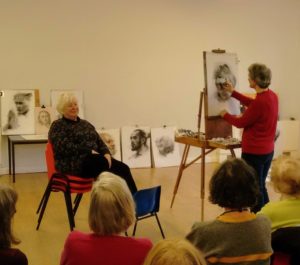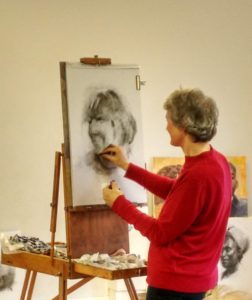Sheila Bryant is a well known local artist and teacher who organises Portrait and Life Drawing classes at St., Nicholas Church Hall. Many club members have attended Sheila’s classes and benefitted from her teaching. Sheila’s demonstration consisted of doing portraits of two volunteer sitters using her ‘rub-out’ technique. Before starting Sheila gave an explanation of how she works. Her approach to doing portraits is based on understanding the effect of light across the surface of the face, looking for the areas of light and shadow to define the portrait. Natural light is best for doing portraits as artificial light is too flat, the lighting in the hall providing a challenging environment for the demonstration. It is good to place the sitter so that there is a wall behind them so that the light reflecting off the wall provides a secondary light source. The shadows define the face based on the bone structure and you are always looking for the structures under the skin, effectively working from the skull outwards. She finds that a side view is better than face on as it provides lots of diagonals and adds interest to the composition.
Marilyn Hay kindly volunteered to act as the first sitter. Sheila used smooth paper from a Windsor & Newton sketch pad and works with compressed charcoal. This type of charcoal is made with oil and therefore doesn’t need fixing. It also produces very little dust. She started by shading in an area on the paper large enough to contain the intended portrait. She then gradually looked for shadows and ‘felt’ for the shape of the face. Sheila described it as almost more like sculpture than drawing. She used a plastic rubber to rub out the charcoal and create lighter areas and used the charcoal to add darker areas. The image was constantly changing and developing as she looked at the model and adjusted her work. Sheila explained that she usually tried to establish some reference points against which to judge the light and dark. The corner of the eye sockets are often useful for this.
Roger volunteered to act as the second sitter and this allowed us to watch Sheila work through her process a second time. She also noted that it usually takes the model about 10 minutes to ‘settle’ in their pose, so it is important not to try and put too much down too soon. The whole method requires you to take you time and carefully observe the sitter.


